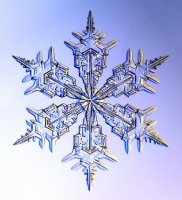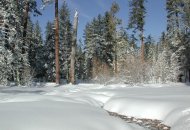|
|
Frequently
Asked Questions
... Things you always wanted to know about snow crystals ... |
|
|
Why do snow crystals form in
such complex and symmetrical shapes? |
 To see why snowflakes look like they do, consider the life history of a
single snow crystal, as shown in the diagram at right. (Click on
the picture for a larger view.)
To see why snowflakes look like they do, consider the life history of a
single snow crystal, as shown in the diagram at right. (Click on
the picture for a larger view.)
The story begins up in a cloud, when a minute cloud droplet first
freezes into a tiny particle of ice. As water vapor starts
condensing on its surface, the ice particle quickly develops
facets, thus becoming a small
hexagonal prism. For a while it keeps this simple faceted
shape as it grows.
As the crystal becomes larger, however,
branches begin to sprout from the six corners of the hexagon (this
is the third stage in the diagram at right). Since the atmospheric
conditions (e. g. temperature and humidity) are nearly constant across
the small crystal, the six budding arms all grow out at roughly the same
rate.
While it grows, the crystal is blown to and fro inside the clouds,
so the temperature it sees changes randomly with time. But the
crystal growth depends strongly on temperature (as is seen in the morphology
diagram). Thus the six arms of the snow crystal each change their growth with
time. And because all six arms
see the same conditions at the same times, they all grow about the same way.
The end result is a complex, branched structure that is also six-fold
symmetric. And note also that since snow crystals all follow slightly
different paths through the clouds, individual crystals all tend to
look different. The story is
pretty simple, really, nicely encapsulated in the diagram above.
And it's even a bit amazing, when you stop to ponder it -- the whole
complex, beautiful, symmetrical structure of a snow crystal simply
arises spontaneously, quite literally out of thin air, as it tumbles
through the clouds. |
|
What synchronizes the growth
of the six arms? |
 Nothing. The six arms of a snow crystal all grow independently, as
described in the previous section. But since they grow under the
same randomly changing conditions, all six end up with similar shapes.
Nothing. The six arms of a snow crystal all grow independently, as
described in the previous section. But since they grow under the
same randomly changing conditions, all six end up with similar shapes.
If you think this is hard to swallow, let me assure you that the
vast majority of snow crystals are not very symmetrical.
Don't be fooled by the pictures -- irregular crystals (see the
Guide to Snowflakes) are by far the most common type. If you
don't believe me, just take a look
for yourself next time it snows. Near-perfect, symmetrical snow
crystals are fun to look at, but they are not common. |
|
Why do snow crystals have
six arms? |
The six-fold symmetry
of a snow crystal ultimately derives from the hexagonal geometry of the
ice crystal lattice. But the lattice has molecular dimensions,
so it's not trivial how this nano-scale symmetry is transferred to the
structure of a large snow crystal.
The way it works is through
faceting. No long-range forces are necessary to form facets;
they appear simply because of how the molecules hook up locally in the
lattice (see
Crystal Faceting for how this works). From faceting we get
hexagonal prisms, which are large structures with six-fold symmetry.
Eventually arms sprout from the corners of a prism, and six corners
means six arms.
Faceting is how the geometry of the water molecule is transferred
to the geometry of a large snow crystal. |
|
Why is snow white? |
 No, it's not a white dye. Snow is made of ice crystals, and
up close the individual crystals look clear, like glass. A large
pile of snow crystals looks white for the same reason a pile of crushed
glass looks white. Incident light is partially reflected by an ice
surface, again just as it is from a glass surface. When you have a
lot of partially reflecting surfaces, which you do in a snow bank,
then incident light bounces around and eventually scatters back out.
Since all colors are scattered roughly equally well, the snow bank
appears white.
No, it's not a white dye. Snow is made of ice crystals, and
up close the individual crystals look clear, like glass. A large
pile of snow crystals looks white for the same reason a pile of crushed
glass looks white. Incident light is partially reflected by an ice
surface, again just as it is from a glass surface. When you have a
lot of partially reflecting surfaces, which you do in a snow bank,
then incident light bounces around and eventually scatters back out.
Since all colors are scattered roughly equally well, the snow bank
appears white.
In fact, the ice does absorbs some light while it's bouncing around,
and red light is absorbed more readily than blue light. Thus, if
you look inside a snow bank you can sometimes see a blue color. I
took a few pictures of this once in the
California mountains. |
|
Is it ever too cold to snow? |
In principle it can
snow at any temperature below freezing. It snows at the South Pole
even though the temperature is rarely above -40 C (-40 F).
In more hospitable climates, however, it doesn't snow so much when
the temperature is below around -20 C (-4 F). When a parcel of
moist air cools, it starts producing snow before it gets that cold.
By the time the temperature drops to -20 C, the snow has already fallen
and the air is pretty dry. The clouds that remain are made of ice
crystals, and these don't produce much snow (see the
Snowflake Primer for how clouds make snow). |
|
Why study the physics of snowflakes? |
There are several good reasons for
studying how snowflakes form.
First of all, crystals are useful in all sorts of applications, and we would like to know how to
grow them better. Computers are carved out of silicon
wafers, which in turn are cut from large silicon crystals. Many
other semiconductor crystals are used for other electronics
applications. Lasers are also made from
crystals, and a variety of optical crystals are used extensively in
telecommunications. Artificial diamond crystals are used in machining
and grinding. The list of industrial crystals is actually quite
long.
By studying the physics of snowflakes, we learn about how molecules
condense to form crystals. This basic knowledge applies to other
materials as well. As we learn more about the physics and chemistry
of how crystals grow, maybe someday we can use
that knowledge to help fabricate new and better types of crystalline
materials.
This is the way that basic science becomes useful -- figure out how
things work the best you can, and later on use that knowledge in
unforeseen applications.
Another good reason to study
snowflakes is to better understand structure formation and
self-assembly. Humans usually make a thing by starting with a block of
material and carving from it. Computers, for example, are made by
patterning intricate circuits on silicon wafers.
Nature uses a completely different approach to manufacturing. In
nature, things simply assemble themselves. Cells grow and divide,
forming complex organisms. Even extremely sophisticated computers (such
as your
brain) arise from self-assembly. Your DNA does not contain nearly
enough information to guide the placement of every cell in your body.
Most of that structure simply arises spontaneously as you grow, following poorly
understood rules. Biological self-assembly is an extremely
complex process, and we do not understand much about how it works at a
fundamental level.
The snowflake is an very simple example of self-assembly. There is
no blueprint or genetic code that guides the growth of a snowflake, yet
marvelously complex structures appear, quite literally out of thin air.
As we understand better how snowflakes form, we learn about
self-assembly. As the electronics industry pushes toward ever
smaller devices, it is likely that self-assembly will play an
increasingly important role in manufacturing. Learning about
self-assembly from the ground up will probably by useful in this context
also. Again, in the study of basic science we try to solve the
easy problems first (like snowflakes), and later use that knowledge to
develop engineering applications we cannot yet foresee.
History has shown over and over that the fundamental knowledge
gained by doing basic science (without worrying about what it's good
for) often leads to useful engineering applications. There is a
great deal of
interesting physics, chemistry, and materials science wrapped up in
snowflake growth, and studying the lowly snowflake may indeed teach us
something useful.
Now, all that being said, my personal motivation is not from potential
practical applications. I am not trying to make better artificial
snow, better ice for Olympic skating, bigger diamonds, faster computers,
or anything like that. I believe that basic science can and should be pursued for its own
sake. Scientists try to understand everything they can about how
nature works, on the premise that all knowledge is potentially useful.
Einstein didn't worry about the practical applications of relativity --
he just wanted to understand how nature worked. Maxwell didn't
think about cell phone technology when he worked out the laws of electromagnetism --
he just wanted to understand how nature worked.
I want to figure out the underlying physics of snowflake growth
because this is an interesting puzzle in molecular dynamics.
I would like to understand the fundamental physics of how molecules jostle into
place to form a crystal. How fast does this happen? How does it
change with temperature? What happens if there are chemical impurities
on the ice surface? There are many such questions, and ice is an
interesting case study in crystal growth. These remarkable
structures simply fall from the sky -- we ought to understand how they
are formed! With over six billion people on the
planet, surely a few of us can be spared to ponder the subtle mysteries
of snowflakes. |
|
Who else is working on the
science of snow crystals? |
Not many people are
thinking about why snow crystals look like they do, and most of them are
meteorologists looking at how snow crystal formation affects the
properties of cold clouds. Here is a partial list (in no
particular order), along with contact information (in the links):
Charles
Knight, National Center for Atmospheric Research
Dennis Lamb,
Jerry
Harrington, Penn State
Brian Swanson,
Marcia Baker, University of Washington
John
Hallett, Desert Research Institute
Raymond Shaw, Michigan Technological University
Norihiko Fukuta, University of Utah
Yoshinori Furukawa, Hokkaido University (Japan)
John Wettlaufer, Yale
University
I have also been collaborating with
David Griffeath and
Janko Gravner, who are mathematicians working on cellular automata
methods for computer modeling of snow crystal formation.
My scientific focus is somewhat different from the meteorologists
in that I am not trying to connect snow crystal formation to clouds or
climate issues. Rather, I am a physicist looking at the
statistical mechanics and molecular dynamics of snow crystal growth.
I am tackling the problem by making precision measurements of crystal
growth rates, by comparing measurements with dynamical theories of
crystal growth, and by examining the mathematics of pattern formation
and growth instabilities that occur during solidification. |
|
